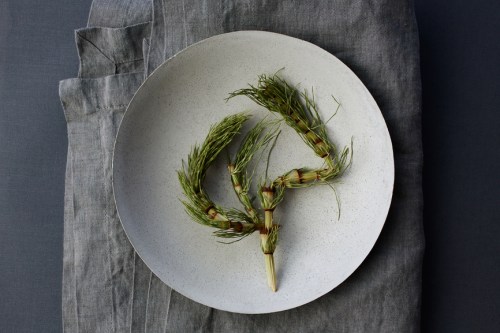Our editors independently select these products. Making a purchase through our links may earn Well+Good a commission
After overindulging in stress, unhealthy stress-coping mechanisms (read: wine), and blood-pressure raising political discussions with climate change-denying relatives, I’m looking forward to January, my favorite month of the year and also prime time for optimizing personal wellness.
To prep, I’ve begun to entertain the side of myself that’s always wanted to be a potion-concocting witch. (So much so that in elementary school, I painstakingly crafted an entire book of spells, only to later destroy it out of Catholic guilt.) My modern-day version of this early art project is to stock my pantry full of plant medicine I can utilize to heal all that ails me in the aftermath of the year that was way, way too much.
One such nature-based remedy I’m looking forward to incorporating into my arsenal is horsetail herb. While its origins in witchcraft are unknown (at least to me), herbalist Rachelle Robinett says it’s one of the oldest-used medicinal plants on the planet. In Ayurveda, it’s used to treat inflammation, and it was also used by Native Americans as a kidney aid, dysuria (read: painful pee) treatment, and diuretic. The latter benefits are born of the plant’s flavonoid (read: antioxidant) and saponin (read: anti-cancer) constituents, Lang explains.
These aren’t only healing properties of horsetail herb. “It’s rich in naturally occurring calcium, magnesium, potassium, and bioavailable silica,” Robinett tells me, noting that it’s actually higher in silica than any other herb. “Silica is an essential trace mineral that restores weak connective tissues in blood vessels, cartilage, tendons, and in collagen–the body glue that helps hold our skin and muscle tissues together,” she goes on to explain. As such, it plays an important role in the development, strengthening, and maintenance of healthy bones and teeth and speeds the healing of bone fractures. “It’s said to help rheumatism and arthritis by improving the elasticity of the joints, and is recommended to athletes for sprains, pulled hamstrings, and torn ligaments,” she adds. It also benefits hair and nail growth, and may be helpful in healing wounds.
Horsetail herb can be consumed in a tincture or as a dried herb. It’s also found in plant-based collagen powder blends, capsules, and teas. If you’re feeling particularly witchy you can also, advises Lang, mix horsetail with stinging nettles to even better facilitate strong bone, fingernail, and hair growth as well as joint repair.
While potential side effects are rare, Robinett says it’s worth noting that horsetail herb can potentially lower vitamin B1 levels, especially if you drink alcohol frequently. Because of its diuretic properties, it may also lower potassium levels and inhibit lithium flushing, thereby increasing the body’s lithium content. Beyond these concerns, Robinett tells me it’s not recommended for pregnant or nursing women, as toxicity similar to nicotine poisoning has been noted in children who’ve ingested large amounts.
Overall, she urges a typical degree of caution. “As with any herb or supplement, folks should start slow at first to ensure no drastic negative reactions,” she says. I suppose this means I should do a little more research (on myself) before I start combining it into elixirs aimed at erasing New Year’s Eve debauchery and, at least this cocktail-drenched time of year, make sure I add in a B vitamin supplement if I’m going to start taking it, too.
Next, what you need to know about the ancient form alternative medicine called cupping:
Before you go wild at your local herb shop, here’s what you should know to stay safe. Plus, here’s how to grow your own, even if you have a brown thumb.
Sign Up for Our Daily Newsletter
Get all the latest in wellness, trends, food, fitness, beauty, and more delivered right to your inbox.
Got it, you've been added to our email list.











